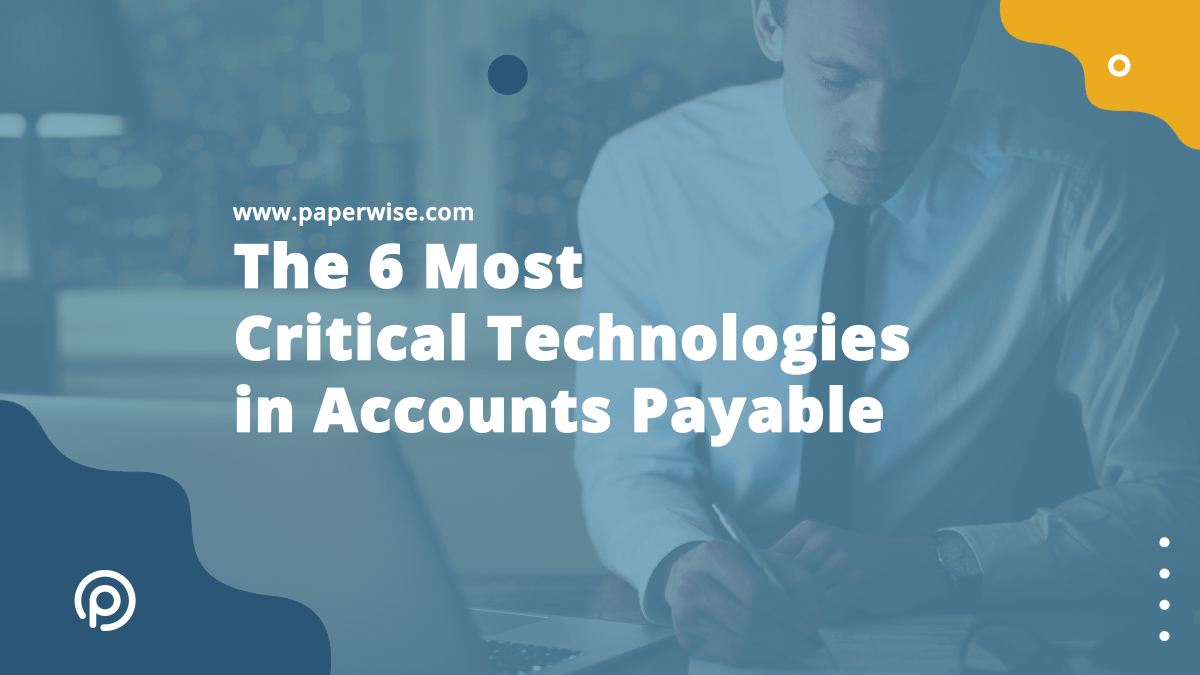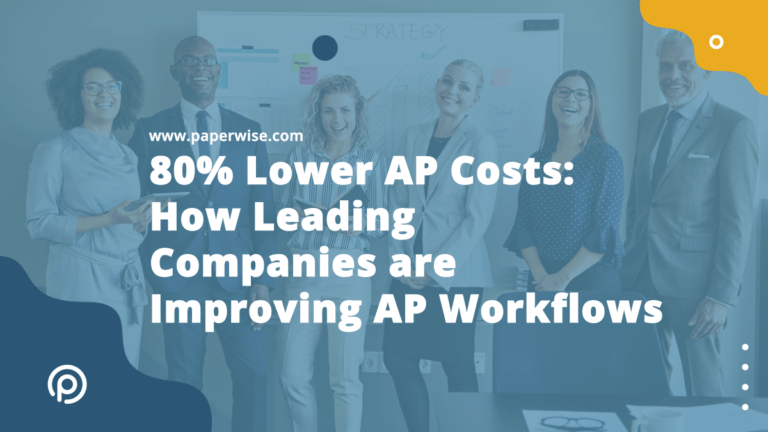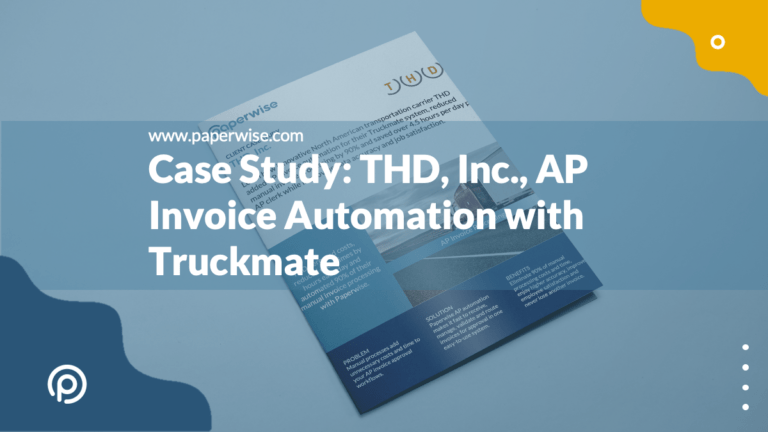Leading CFOs and controllers face many options when it comes to improving the efficiency and effectiveness of their operations. According to the Institute of Finance and Management’s study, “The Future of Accounts Payable,” 75.2% of AP leaders are looking at AP process automation as a priority.
We’ve compiled a list of the six (6) most critical technologies for accounts payable. Implementing these solutions will improve your efficiency, reduce your costs, improve your vendor relationships and put you on track with best-in-class AP departments.
1. Intelligent Invoice Capture
Business gets more complex every day and that holds true for our accounts payable processes. One of the biggest areas of complexity AP departments face has to do with receiving and managing invoices. It seems like every vendor uses a different method to send invoices in: paper, EDI, email and more. Each invoice – sometimes even from the same vendor – has a completely unique format and layout making it difficult for a human to easily find and read simple necessary information like vendor name, invoice number, PO number or other key data. Some vendors send invoices that are overly complex, others that are missing information in their simplicity.
Intelligent invoice capture addresses these issues with a scalable and automated solution for receiving all of your AP invoices. Paperwise provides you with a single platform to take in AP invoices of any kind, shape, format and quality and quickly digitize and extract information. The process is faster than manual processes. Paperwise’s smart capture can even learn from previous invoices, so your processes become more automated over time. In fact, as much as 90% of the invoices you receive can be recognized and processed through automation.
2. Anytime and Anywhere Access
After eliminating 90% of the manual work involved in receiving and processing invoices, AP invoice approvals are the next biggest bottlenecks in your entire AP workflow. Our experience shows that at least three (3) people in your organization must work with an invoice during it’s AP cycle: an AP or data entry clerk, an approving manager and a payment approver. But in many cases, up to 15 different people in your organization are involved in AP approvals: PO issuers have to resolve discrepancies, managers need to review exceptions, approval limits are exceeded and invoices need to be escalated for approval, CFOs might get involved for larger expenditures and on and on. It gets worse if you have to chase down status on an invoice or an approver forgets to pass the invoice along in a timely fashion.
It’s no wonder that remote invoice access is such an important priority for AP departments. It dramatically accelerates the approval process and cycle times. According to the Institute of Finance and Management, best-in-class companies process a single AP invoice in 3.6 days while most companies take 16.6 days. That can make an enormous difference in early payment discounts that typically range from 0-15 days. Some companies also calculate the percentage of payments made on time.
3. Low-code Process Automation
Unfortunately, most software systems are difficult to customize. That means you either have to change your processes to match your software capabilities or come up with clunky workarounds. These workarounds might involve expensive customization projects with developers and data engineers or they might simply involve overly complex spreadsheets.
The better answer to building workflows that match your strategies and corporate governance rules is through low-code process automation. Paperwise process automation allows you to set up the exact workflows and rules you need without expensive customization projects. It’s so simple to use, you could be up and running with new processes in a matter of days.
Low-code Process Automation is Especially Important in Accounts Payable
So many of our processes in accounts payable would benefit from automation:
- How much time does your team spend reading, routing and entering data – time that would be better spent with more strategic management activities and data analysis?
- What if you could eliminate 80% to 90% of your manual transaction processing work?
- What would you do if a senior AP employee left your company and no one else understood the various rules and issues regarding their key vendors?
- What do you think is a better approach to unstructured data: manual human analysis or self-learning software?
- How much time is spent just finding lost documents?
All of these common AP issues are easily addressed with AP process automation.
4. Data and Workflow Visualizations
One of the often overlooked benefits of managing your accounts payable process through automated workflows is the ability to analyze each and every step of the process. What gets measured gets managed and what gets managed improves over time. Analyzing your entire AP cycle can help you answer important questions like:
- How long does it take to process and invoice and which types of invoices and vendors take the longest?
- What is the real cost across our organization of our AP process?
- How large does my AP department need to be as I scale more company?
- Which invoices require manual intervention and why?
- Which of my vendors have the highest percentage of errors, disputes and inconsistencies?
- How can I better forecast and manage my days payable outstanding?
- What percent of payment discounts are we capturing?
5. Collaboration Capabilities
Every accounts payable department faces issues with disputes, irregularities, questions, research and other issues related to collaboration. Resolving disputes is often cited as the least favorite activity among AP clerks.
With Paperwise, all of your data is stored and work is done in one secure location. It ensures everyone has access to current information and documentation, so you spend less time controlling data and more time collaborating. This provides you with many benefits over manual processes, such as:
- Providing everyone inside and outside of your organization with a clear communication and approval processes that apply to all of your vendors
- Giving vendors and employees a secure, self-serve portal to access necessary documents to answer questions and view status
- Improving vendor relationships with consistent, clear and straightforward dispute resolution and access to the same digitized documents
- Making it easier than ever to onboard and work with new vendors of any size or any technological capabilities
6. Management System Integration
No matter how efficient your AP process automation is at scanning, digitizing and routing invoices for approval, if someone has to then manually enter information into your ERP or business system to complete your invoice cycle you’ve lost at least 40% of your efficiency and accuracy. Unfortunately, integration can be difficult, expensive and requires specialized expertise so many AP solutions lack this critical last-mile capability. Paperwise is a leading expert in system integrations and we partner with leading management software systems so that your entire process from invoice to payment is touch-free.
Getting Started With Accounts Payable Technology
Where will you start in your journey to better AP process automation? We’ve helped hundreds of companies improve their process through low-code business process automation and we’d be happy to help you get started. Please contact us today to set up a free, no-obligation consultation about your current AP workflows and goals.




